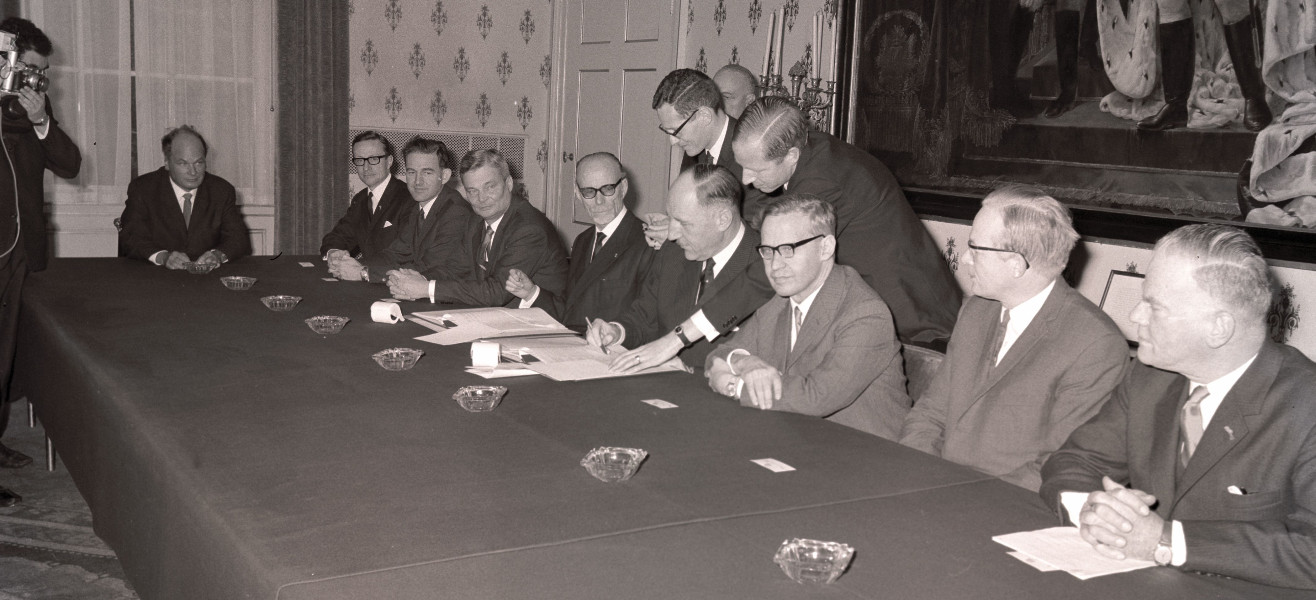February’s Object of the Month looked back to 2014 and the celebrations of 50 years of space cooperation. The month, we go further back still, to 1964 and the formal beginnings of this story, with the creation of ELDO and ESRO in February and March 1964 respectively.
Just over 60 years ago, the ELDO Convention entered into force on 29 February 1964 (another leap year) and the ESRO Convention entered into force three weeks’ later, and exactly 60 years ago today, on 20 March 1964. These two dates therefore represent the creation of the European Launcher Development Organisation and the European Space Research Organisation, and the start of formal European cooperation in space. But tempting as it is to view 1964 as Europe’s ‘year zero’ in space, this belies the years of campaigning and preparatory work by stakeholders, scientists and policymakers across the continent to bring this goal to fruition.
Primary among these was the committee known as COPERS, the European Preparatory Commission for Space Research. The creation of ESRO was the ultimate achievement of COPERS, set up in the early 1960s to pave the way for the establishment of an international organisation for common European space programmes: COPERS operated from 1961, with its first meeting in Paris in March 1961, until 1964, by which time it had achieved its aim to work itself out of a job!
COPERS established two working groups at the outset: an interim Scientific and Technical Working Group (STWG) to define the scientific programme, and a Legal, Administrative and Financial Working Group (LAFG), dealing with facilities, budgets and the preparation of a convention, among other tasks. By the end of 1961, the third plenary session of COPERS had approved the initial eight-year programme of ESRO, proposed by the STWG – known as the Blue Book. And six months later, on 14 June 1962, the ESRO Convention opened for signature by Belgium, Denmark, France, Germany, Italy, The Netherlands, Spain, Sweden, Switzerland and the United Kingdom.
In contrast, the creation of ELDO, began with the work of national delegates from the twelve European countries who convened at an intergovernmental conference in Strasbourg on 30 January 1961. This culminated in the Lancaster House conference of October 1961 at which delegates from seven countries (and Australia as host of ELDO’s proposed launch facilities at Woomera) agreed the schedule for the proposed five-year Initial Programme (IP) and discussed financial resources. National delegates also established a Preparatory Group to set up the organisation and coordinate the IP, which in its turn created a Technical and Administrative Committee, followed shortly after by a Secretariat.
The ELDO Convention subsequently opened for signature by Belgium, France, Germany, Italy, The Netherlands, the United Kingdom and Australia as Associate Member, on 29 March 1962
The different ELDO and ESRO paths
The roots of the differences between these two organisations, and the correspondingly different ways in which they came into existence can be found in the consensus held in the early 1960s that European space endeavours would be best served by two bodies: ESRO for research in space science - created along the lines of CERN and unconnected to launcher development (to minimise any risk to collaboration with neutral countries); and ELDO to collaborate with engineers and industry on the development of a European launcher.
And they are, accordingly, also mirrored in the texts of their relative conventions. As Michelangelo De Maria notes in his History of ELDO Part 1, while there were superficial similarities, in structures which consisted of a Council with decisional responsibility and political authority, ELDO had no defined programme of missions, no definite users (for its launchers) and no performance targets in its convention. ESRO, on the other hand, had well-defined scientific aims and had outlined performance objectives including the launch of two satellites from its sixth year of life.
In terms of structure, there were also major variations. ELDO’s Convention authorised its Member States to place contracts (which led to issues resulting from the different contractual systems in place across them, and the resulting lack of coordination), whereas ESRO’s Convention gave the organisation corporate status and authorised it to enter into contracts.
This corporate status, enshrined in Article 14, also gave its Director General the authority to sign agreements with Member States hosting ESRO establishments. The image above shows the signing of the agreement on the establishment and operation of the European Space Technology Centre (ESTEC) between Pierre Auger, ESRO Director General, and Joseph Marie Antoine Hubert Luns, Dutch Minister of Foreign Affairs, in February 1967. (This is often the image used to accompany text talking about the signature of the ESRO Convention, since there is an astonishing gap in the holdings of both the ECSR and the HAEU, with neither Archive having photographs of the signing!)
The authority of the two organisations also came from different political sources. The ESRO Convention had been drafted by the national delegates of COPERS who nearly all came from the European scientific community or from national ministries dealing with science. Conversely, the national delegates involved in drawing up ELDO’s Convention came from a range of ministries spanning also finance or foreign affairs.
De Maria goes on to note that ELDO’s secretariat was left with little power over its technical and financial management. In the words of Herman Bondi, ESRO’s second Director General, “an impossible management structure’’, and one that would go on to define its destiny.
More about the ESRO Convention
A 1960s reprint of the ESRO Convention forms part of the holdings of the ECSR and a digitised version of this is now open in the Archives’ SHIP database.
More about the ELDO Convention
The ELDO fonds form part of the ESA historical archives held at the Historical Archives of the European Union, based at the European University Institute in Florence. Newly digisited material has recently been added by our colleagues at HAEU to mark the 60th anniversary of the ELDO Convention.
